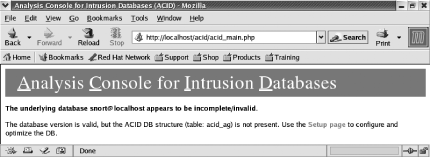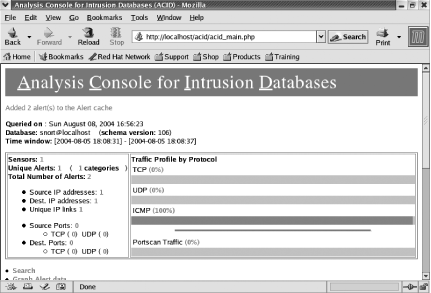Installing and Configuring ACID
Problem
You want to use ACID to analyze your Snort output.
Solution
Follow the recipes for Installing and Configuring MySQL (Recipe 2.11), Installing Snort Binaries on Linux (Recipe 1.2), and Configuring MySQL for Snort (Recipe 2.12). Make sure when you install Snort that you use the configure --with-mysql=/usr/local/mysql option.
First, install Apache. At the time of this writing, the current version is 2.0.50. Use the following commands to install Apache:
[root@localhost root]# tar zxvf httpd-2.0.50.tar.gz [root@localhost root]# cd httpd-2.0.50 [root@localhost httpd-2.0.50]# ./configure --prefix=/www --enable-so [root@localhost httpd-2.0.50]# make [root@localhost httpd-2.0.50]# make install [root@localhost httpd-2.0.50]# /www/bin/apachectl start
Next, check the system to make sure the web server is working by opening a web browser and entering your IP address or "localhost." You should see the default Apache web page.
Next, install PHP. You must install Version 4.3.8 because the current version, 5.0.0, does not work with ACID. Use the following commands to install PHP:
[root@localhost root]# tar zxvf php-4.3.8.tar.gz [root@localhost root]# cd php-4.3.8 [root@localhost php-4.3.8]# ./configure --prefix=/www/php --with-apxs2= /www/bin/apxs --with-config-filepath=/www/php --enable-sockets --with-mysql=/usr/local/mysql --with-zlib-dir=/usr/local --with-gd [root@localhost php-4.3.8]# make [root@localhost php-4.3.8]# make install [root@localhost php-4.3.8]# cp php.ini-dist /www/php/php.ini
Make the following changes to the /www/conf/httpd.conf file:
[root@localhost php-4.3.8]# cd /www/conf [root@localhost conf]# vi httpd.conf
Change the line:
DirectoryIndex index.html index.html.var
to:
DirectoryIndex index.php index.html index.html.var
Also, add the following line under the AddType section:
AddType application/x-httpd-php .php
Next, make the following changes to create links for startup scripts so that the web server starts when you boot up in run levels 3 and 5 (run level 3 is full multiuser mode, and run level 5 is the X Window System):
[root@localhost conf]# cd /www/bin [root@localhost bin]# cp apachectl /etc/init.d/httpd [root@localhost bin]# cd /etc/rc3.d [root@localhost rc3.d]# ln -s ../init.d/httpd S85httpd [root@localhost rc3.d]# ln -s ../init.d/httpd K85httpd [root@localhost rc3.d]# cd /etc/rc5.d [root@localhost rc5.d]# ln -s ../init.d/httpd S85httpd [root@localhost rc5.d]# ln -s ../init.d/httpd K85httpd
Next, test the configuration with the following commands:
[root@localhost rc5.d]# cd /www/htdocs [root@localhost htdocs]# echo "" > test.php [root@localhost htdocs]# /etc/init.d/httpd stop [root@localhost htdocs]# /etc/init.d/httpd start
Open the web browser again and enter http://IPaddress/test.php or http://localhost/test.php. You should see a PHP table output of system information.
Next, install adodb. At the time of this writing, the latest version is 4.5.1:
[root@localhost root]# tar zxvf adodb451.tgz [root@localhost root]# cp -R ./adodb/ /www/htdocs
Next, install JPGraph. The current version at the time of this writing is 1.16. Use the following commands to install JPGraph:
[root@localhost root]# cp jpgraph-1.16.tar.gz /www/htdocs [root@localhost root]# cd /www/htdocs [root@localhost htdocs]# tar zxvf jpgraph-1.16.tar.gz [root@localhost htdocs]# rm -rf jpgraph-1.16.tar.gz
Now you are ready to install ACID. The current version at the time of this writing is 0.9.6b23. Use the following commands to install ACID:
[root@localhost htdocs]# cd /root [root@localhost root]# cp acid-0.9.6b23.tar.gz /www/htdocs [root@localhost root]# cd /www/htdocs [root@localhost htdocs]# tar zxvf acid-0.9.6b23.tar.gz [root@localhost htdocs]# rm -rf acid-0.9.6b23.tar.gz [root@localhost htdocs]# cd acid [root@localhost acid]# vi acid_conf.php
Next, you must make a few configuration changes. Make sure the /www/htdocs/acid/acid_conf.php file contains the following information:
$DBlib_path = "/www/htdocs/adodb"; /* Alert DB connection parameters * - $alert_dbname : MySQL database name of Snort alert DB * - $alert_host : host on which the DB is stored * - $alert_port : port on which to access the DB * - $alert_user : login to the database with this user * - $alert_password : password of the DB user * * This information can be gleaned from the Snort database * output plugin configuration. */ $alert_dbname = "snort"; $alert_host = "localhost"; $alert_port = ""; $alert_user = "root"; $alert_password = "newpassword"; /* Archive DB connection parameters */ $archive_dbname = "snort"; $archive_host = "localhost"; $archive_port = ""; $archive_user = "root"; $archive_password = "newpassword"; $ChartLib_path = "/www/htdocs/jpgraph-1.16/src";
To continue with the configuration, open a web browser to http://localhost/acid/acid_main.php (Figure 5-16). Click on the Setup page link to continue (Figure 5-17).
Figure 5-16. ACID initial setup page

Figure 5-17. ACID database setup

Next, click the button that says Create ACID AG. You now see that four tables were successfully created (Figure 5-18). Now when you go back to the main ACID page, it displays the Snort sensor statistics (Figure 5-19).
Figure 5-18. ACID database setup complete

Figure 5-19. ACID main page

Discussion
The Analysis Console for Intrusion Databases (ACID) is a great tool to use for viewing, analyzing, and graphing your Snort logs. It is a PHP-based analysis engine that searches and processes your IDS database logs. Some of its features include a search engine, packet viewer, alert management, and graphing and statistics generation.
There are several prerequisites to installing ACID, including MySQL, Apache, PHP, ADODB, JPGraph, and Snort. The example provided installs ACID and its prerequisites on a default installation of Red Hat 9. When using other versions of Unix or Linux, you must download and install the appropriate prerequisites for your platform.
Keeping up with alerts and logs is one of the hardest parts of managing an IDS. Using a tool like ACID makes the IDS administrator's job a lot easier. Its web frontend, ease of use, and features make it an invaluable tool to have for IDS data analysis.
See Also
http://www.andrew.cmu.edu/user/rdanyliw/snort/snortacid.html
http://www.aditus.nu/jpgraph/jpdownload.php
http://httpd.apache.org/download.cgi
http://www.php.net/downloads.php
http://adodb.sourceforge.net/
Recipe 2.11
Recipe 2.12
Recipe 1.4
Recipe 1.2
Recipe 5.3
Securing ACID |
Installing Snort from Source on Unix
- Installing Snort from Source on Unix
- Installing Snort Binaries on Linux
- Installing Snort on Solaris
- Installing Snort on Windows
- Uninstalling Snort from Windows
- Installing Snort on Mac OS X
- Uninstalling Snort from Linux
- Upgrading Snort on Linux
- Monitoring Multiple Network Interfaces
- Invisibly Tapping a Hub
- Invisibly Sniffing Between Two Network Points
- Invisibly Sniffing 100 MB Ethernet
- Sniffing Gigabit Ethernet
- Tapping a Wireless Network
- Positioning Your IDS Sensors
- Capturing and Viewing Packets
- Logging Packets That Snort Captures
- Running Snort to Detect Intrusions
- Reading a Saved Capture File
- Running Snort as a Linux Daemon
- Running Snort as a Windows Service
- Capturing Without Putting the Interface into Promiscuous Mode
- Reloading Snort Settings
- Debugging Snort Rules
- Building a Distributed IDS (Plain Text)
- Building a Distributed IDS (Encrypted)
Logging to a File Quickly
- Logging to a File Quickly
- Logging Only Alerts
- Logging to a CSV File
- Logging to a Specific File
- Logging to Multiple Locations
- Logging in Binary
- Viewing Traffic While Logging
- Logging Application Data
- Logging to the Windows Event Viewer
- Logging Alerts to a Database
- Installing and Configuring MySQL
- Configuring MySQL for Snort
- Using PostgreSQL with Snort and ACID
- Logging in PCAP Format (TCPDump)
- Logging to Email
- Logging to a Pager or Cell Phone
- Optimizing Logging
- Reading Unified Logged Data
- Generating Real-Time Alerts
- Ignoring Some Alerts
- Logging to System Logfiles
- Fast Logging
- Logging to a Unix Socket
- Not Logging
- Prioritizing Alerts
- Capturing Traffic from a Specific TCP Session
- Killing a Specific Session
How to Build Rules
- How to Build Rules
- Keeping the Rules Up to Date
- Basic Rules You Shouldnt Leave Home Without
- Dynamic Rules
- Detecting Binary Content
- Detecting Malware
- Detecting Viruses
- Detecting IM
- Detecting P2P
- Detecting IDS Evasion
- Countermeasures from Rules
- Testing Rules
- Optimizing Rules
- Blocking Attacks in Real Time
- Suppressing Rules
- Thresholding Alerts
- Excluding from Logging
- Carrying Out Statistical Analysis
Detecting Stateless Attacks and Stream Reassembly
- Detecting Stateless Attacks and Stream Reassembly
- Detecting Fragmentation Attacks and Fragment Reassembly with Frag2
- Detecting and Normalizing HTTP Traffic
- Decoding Application Traffic
- Detecting Port Scans and Talkative Hosts
- Getting Performance Metrics
- Experimental Preprocessors
- Writing Your Own Preprocessor
Managing Snort Sensors
- Managing Snort Sensors
- Installing and Configuring IDScenter
- Installing and Configuring SnortCenter
- Installing and Configuring Snortsnarf
- Running Snortsnarf Automatically
- Installing and Configuring ACID
- Securing ACID
- Installing and Configuring Swatch
- Installing and Configuring Barnyard
- Administering Snort with IDS Policy Manager
- Integrating Snort with Webmin
- Administering Snort with HenWen
- Newbies Playing with Snort Using EagleX
Generating Statistical Output from Snort Logs
- Generating Statistical Output from Snort Logs
- Generating Statistical Output from Snort Databases
- Performing Real-Time Data Analysis
- Generating Text-Based Log Analysis
- Creating HTML Log Analysis Output
- Tools for Testing Signatures
- Analyzing and Graphing Logs
- Analyzing Sniffed (Pcap) Traffic
- Writing Output Plug-ins
Monitoring Network Performance
- Monitoring Network Performance
- Logging Application Traffic
- Recognizing HTTP Traffic on Unusual Ports
- Creating a Reactive IDS
- Monitoring a Network Using Policy-Based IDS
- Port Knocking
- Obfuscating IP Addresses
- Passive OS Fingerprinting
- Working with Honeypots and Honeynets
- Performing Forensics Using Snort
- Snort and Investigations
- Snort as Legal Evidence in the U.S.
- Snort as Evidence in the U.K.
- Snort as a Virus Detection Tool
- Staying Legal
Index
EAN: 2147483647
Pages: 167
